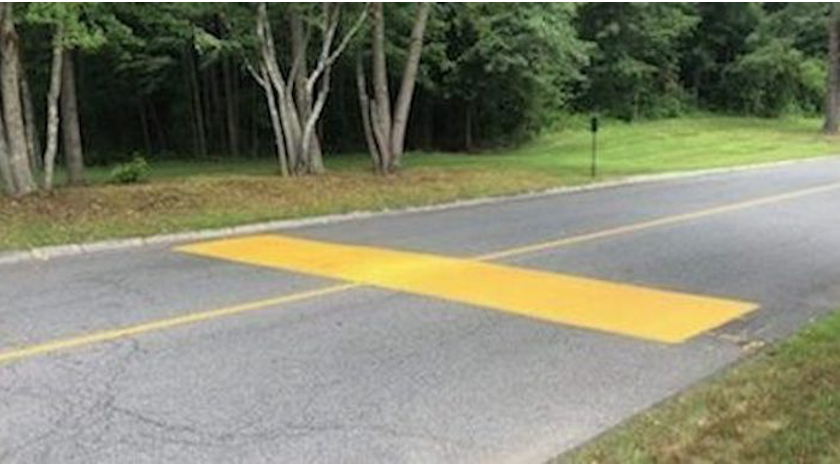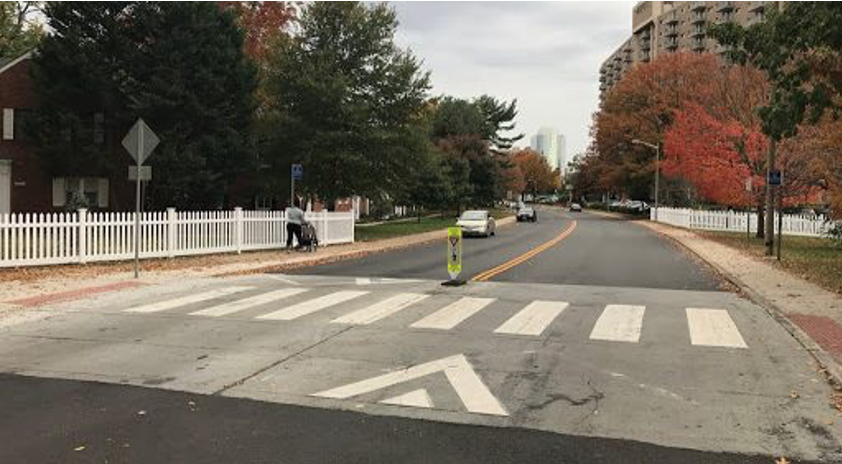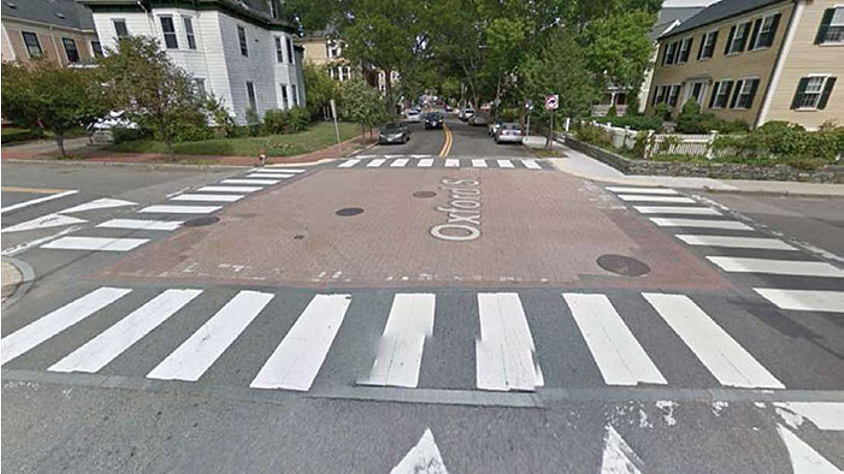Vertical deflection countermeasures are raised areas and bumps in the road that are designed to both slow vehicle speed and enhance safety for pedestrians by physically and/or visually marking crosswalks.
Features
| Speed bumps/ humps/ cushions | Raised pedestrian crossings | Raised intersections |
|---|---|---|
| By deflecting both the wheels and frame of a traveling vehicle, these features encourage drivers to travel at a slow speed in both directions, as well as over the speed bump itself. | These features provide a designated safe route for pedestrians across vehicular roadways where the pedestrian walking surface is raised to the same level—or close to the same level—as the sidewalks that access the pedestrian crossing. | These raised areas act as speed tables, covering an entire intersection with ramps on all vehicular approaches to slow vehicle traffic through the intersection and improve safety for pedestrians. |
Costs & considerations
| Feature | Estimated cost* | Percent speed reduction |
|---|---|---|
| Speed humps/bumps | $2,000-$5,000, depending on drainage conditions and materials | 14-34% |
| Raised crosswalks | $5,000-$7,000, depending on drainage conditions and materials | 12-29% |
| Raised intersections | $25,000-$70,000 | N/A |
*Note: Estimates are based on past projects and commonly used materials, and may vary depending on roadway condition, location, time, and other factors. The speed reduction percentages were sourced from FHWA's Engineering Speed Management Countermeasures Table linked in the resources below.
Potential speed benefits
Vertical countermeasures have been found to effectively reduce the speed most people drive on a road. In one analysis, speed humps were found to reduce the 85th percentile speed by 22 percent on urban roads. (FHWA Speed Management Toolkit: Table 4)
These measures can also offer additional safety benefits, such as enhanced access for people with ambulatory disabilities, without impacting on-street parking or adjacent property if this is a concern. On one street in Cambridge, Massachusetts, installing raised devices increased the number of drivers who yielded to pedestrians from approximately 10% to 55%.
Visit the FHWA table on potential speed reduction for more information. While this data is all collected under differing circumstances and in different environments (volume of vehicles, rural vs. urban areas, etc.), it is still a helpful gauge for what each countermeasure can do.
Learn more about vertical countermeasures
When considering vertical countermeasures, it’s important to keep in mind the MassDOT Project Development Guidelines (Chapter 16). These are specific design policies and standards that you will need to adhere to, so that any changes you make meet federal and state guidelines. Keep in mind that these countermeasures should be considered as part of an iterative process; if a target speed is lower than vertical countermeasures can help realize, they may need to be implemented with other, concurrent measures.
For example:
- Speed guidelines for these measures: e.g. roads with an 85th percentile speed over 30 mph, should not contain speed bumps/humps.
- Speed humps height: typically 3-4 inches in height at their center, and 12-14 feet wide.
- Pedestrian crossing slope: should not exceed 1:10 or be less steep than 1:25.
- Maximum spacing between each speed bump/hump: 500 feet.
- Signage should alert snow-clearing vehicle drivers to raised speed reducers on the road.
- Drainage design considerations.
Many of these details are included in Chapter 16 of our guide.
You can find more information about vertical countermeasures in these resources:
Additional Resources
-
Open PDF file, 193.29 KB, Amherst - Raised crossing on College Street (SR 9) (English, PDF 193.29 KB)
-
Open PDF file, 352.28 KB, Belmont - Raised crosswalks on Cross Street (English, PDF 352.28 KB)
-
Open PDF file, 401 KB, Boston - Side street crossing tables on Tremont Street (English, PDF 401 KB)
-
Open PDF file, 407.64 KB, Cambridge - Side street crossing tables on Western Avenue (English, PDF 407.64 KB)
-
Open PDF file, 415.73 KB, Dedham - Raised intersection on Needham Street (English, PDF 415.73 KB)
-
Open PDF file, 400.64 KB, Mansfield - Speed bumps on Highland Ave., Draper Ave., and Howe St. (English, PDF 400.64 KB)
-
Open PDF file, 297.71 KB, Salem - Speed cushions on Proctor Street (English, PDF 297.71 KB)
-
Open PDF file, 309.78 KB, Salem - Speed humps: North Salem Neighborhood (English, PDF 309.78 KB)
-
Open PDF file, 181.26 KB, Somerville - Speed humps on a busy minor arterial: Powder House Boulevard (English, PDF 181.26 KB)
-
Open PDF file, 336.92 KB, Speed Management Cut Sheets - Median crossing island (English, PDF 336.92 KB)
-
Open PDF file, 273.02 KB, Speed Management Cut Sheets - Raised intersections (English, PDF 273.02 KB)
-
Open PDF file, 340.11 KB, Speed Management Cut Sheets - Side street crossing tables (English, PDF 340.11 KB)
-
Open PDF file, 251.44 KB, Speed Management Cut Sheets - Speed cushions (English, PDF 251.44 KB)
-
Open PDF file, 347.28 KB, Speed Management Cut Sheets - Speed humps (English, PDF 347.28 KB)
-
Open PDF file, 260.15 KB, Speed Management Cut Sheets - Thru street crossing table (English, PDF 260.15 KB)
-
Open PDF file, 479.91 KB, UMass campus wide safety improvements speed humps (English, PDF 479.91 KB)


